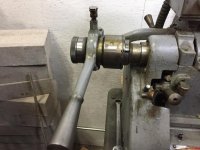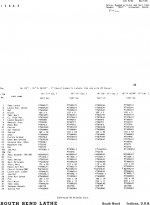I need specific instructions on setting the clutch stop nut on the drawbar of a lever collet closer on my 16" SBL. If the stop nut is threaded on the draw bar to the limit of the thread engagement the Lever will not break over center so I'm assuming that one backs off the stop nut a certain amount until the lever will break over. I thought I had the adjustment correct until I was using a 3/16" end mill in a 3/16" (Hardinge) collet and the lever would stop short of breaking over. I initially set the stop nut using a much larger collet, again Hardinge. I'm suspecting SB did not intend the end user to readjust stop nut location so; what is the correct procedure?
How to install the app on iOS
Follow along with the video below to see how to install our site as a web app on your home screen.
Note: This feature may not be available in some browsers.
You are using an out of date browser. It may not display this or other websites correctly.
You should upgrade or use an alternative browser.
You should upgrade or use an alternative browser.
South Bend lever collet closer
- Thread starter JR Lesan
- Start date
- Replies 13
- Views 1,787
carlherrnstein
Aluminum
- Joined
- Apr 18, 2015
- Location
- Ross County, Ohio
I'm having a hard time understanding your terminology and what your problem is exactly.
Set the collet too the stock you are using, don't set it to some "perfect" size and put stock through it that's a different size, it doesn't work like that. 5c collets have a clamping range of about +.005 -.015 of the nominal size, your stock can be a little small and it still works because the collet springs open and releases it if it's too big the stock will drag in the collet when released. If the handle won't snap over loosen the adjustment some, if it won't hold the part, tighten it. You don't have to make it super tight, it's just more effort to operate the closer.
Set the collet too the stock you are using, don't set it to some "perfect" size and put stock through it that's a different size, it doesn't work like that. 5c collets have a clamping range of about +.005 -.015 of the nominal size, your stock can be a little small and it still works because the collet springs open and releases it if it's too big the stock will drag in the collet when released. If the handle won't snap over loosen the adjustment some, if it won't hold the part, tighten it. You don't have to make it super tight, it's just more effort to operate the closer.
jim rozen
Diamond
- Joined
- Feb 26, 2004
- Location
- peekskill, NY
" I'm suspecting SB did not intend the end user to readjust stop nut location..."
They did. You need to adjust the collet closer for snap-over for each size of workpiece, even when using the
same collet. The adjustment is quite sensitive and will need to be re-set even if the workpiece size is just a few
thousanths different.
They did. You need to adjust the collet closer for snap-over for each size of workpiece, even when using the
same collet. The adjustment is quite sensitive and will need to be re-set even if the workpiece size is just a few
thousanths different.
I suspect no one out there is understanding the question I'm trying to ask. The atop nut threads onto the draw bar and is locked into position on the draw bar by tightening two setscrews (#9) with two brass shoes (#8) which are located between end of said setscrew and external threads on the lever end of the draw bar. Said shoes purpose is to keep set screws from damaging external threads on draw bar. Once lock nut is secured to the drawbar, the user can then install and adjust collets for workholding. If I thread said stop nut onto the drawbar to the limit of thread engagement and tighten setscrews, the lever will not 'break over center' and therefore will not remain in locked position with lathe running. When I back off stop nut from 100% thread engagemnet with drawbar (in other words, loosen it) so that a 1" workpiece is properly held in a hardinge collet AND the lever DOES break over center all is well. However, when I replace the 1" collet with a 3/16" Hardinge collet and attempt to hold a 3/16" end millwith proper collet engagement, (by turning the stop nut which was locked to the drawbar via two setscrew) as has been previously described by others, the leverwill no longer break over center. Therefore, was it intended by SB for the user to adjust stop nut TO drawber thread engagement until any and all collets successfully allowed lever to break overcenter? Does the fact that the stop nut is only partially threaded onto the drawbar have any negative effects?
A very longwinded explanation of my original question...
A very longwinded explanation of my original question...
We do understand the question if you really mean the "stop nut" per the SB parts diagram (item #6 on my parts diagram). In the parts diagram, it does show one set screw (#28) that it calls the "stop nut screw". I can only assume that that screw is used in a production environment where you do not want to run the risk of the setting changing since you are doing a very long run of the same size stock. Your part numbers do not correlate with my diagram. The shoes you refer to are yoke segments on my diagram. I am not in front of my lathe at the moment but they maybe used with the lever?
Ken
Ken
You might find this post useful:
https://www.practicalmachinist.com/...-closer-195227/?highlight=lever+collet+closer
Ken
https://www.practicalmachinist.com/...-closer-195227/?highlight=lever+collet+closer
Ken
Found your diagram online - it has two similar looking nuts and a pin so different than my diagram. Found a picture of mine and it looks like mine might be more like your diagram.

But mine is still used as described - the set screws on that nut (part # 30) are not tightened such that the nut can not turn. I adjust that nut for every stock size in order to get the correct "snap action" when tightening the collet. Speed chucks are nicer for only mounting stock of one size once but the lever collet closer is very nice when doing multiple closures on a given size.
Ken

But mine is still used as described - the set screws on that nut (part # 30) are not tightened such that the nut can not turn. I adjust that nut for every stock size in order to get the correct "snap action" when tightening the collet. Speed chucks are nicer for only mounting stock of one size once but the lever collet closer is very nice when doing multiple closures on a given size.
Ken
jim rozen
Diamond
- Joined
- Feb 26, 2004
- Location
- peekskill, NY
"I suspect no one out there is understanding the question I'm trying to ask."
Correct. A question for you: does your collet setup have part 32, as shown in this diagram? It's a long thin steel pin.
1) is your problem that you need to slack the setscrew (11) inside one of the knurled handles on the closer before you can
adjust the snap-over point on the closer?
2) if 'yes' then *remove* that pin.
Similar threads
- Replies
- 3
- Views
- 598




